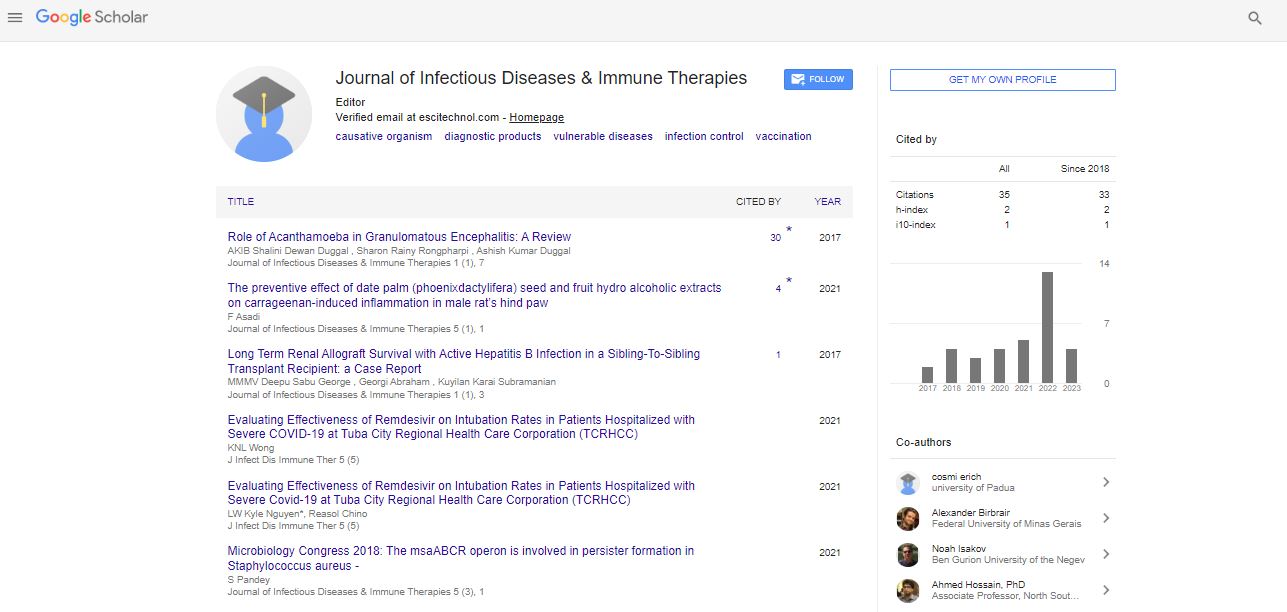Opinion Article, J Infect Dis Immune Ther Vol: 7 Issue: 1
Mucormycosis: Fungal Infections with Clinical Challenges
Kathy Auger*
Department of Nephrology, Internal Medicine, University Medical Center of Utrecht, Utrecht, The Netherlands
*Corresponding Author: Kathy Auger
Department of Nephrology, Internal Medicine, University Medical Center of Utrecht, Utrecht, The Netherlands
E-mail: kathaug@umcutrecht.nl
Received date: 03 February, 2023, Manuscript No. JIDITH-23-96358;
Editor assigned date: 07 February, 2023, PreQC No. JIDITH-23-96358 (PQ);
Reviewed date: 21 February, 2023, QC No. JIDITH-23-96358;
Revised date: 28 February, 2023, Manuscript No. JIDITH-23-96358 (R);
Published date: 07 March, 2023, DOI: 10.4172/JIDITH.1000157
Citation: Auger K (2023) Mucormycosis: Fungal Infections with Clinical Challenges. J Infect Dis I mmune Ther 7:1.
Description
Mucormycosis, also known as zygomycosis, is a rare but serious fungal infection caused by fungi of the order Mucorales. Mucormycosis is known for its aggressive nature and ability to cause severe infections with high morbidity and mortality rates. In recent years, mucormycosis has gained significant attention as an emerging fungal infection, particularly in immunocompromised patients, such as those with diabetes, malignancies, organ transplants, and severe trauma.
Epidemiology of mucormycosis
Mucormycosis is considered an opportunistic infection, occurring primarily in individuals with underlying risk factors, such as uncontrolled diabetes, neutropenia, corticosteroid use, iron overload, and other immunosuppressive conditions. Mucorales fungi are ubiquitous in the environment, and infection typically occurs through inhalation of fungal spores or direct inoculation into wounds. The incidence of mucormycosis has been increasing globally, especially in regions with high prevalence rates of diabetes and immunosuppressive conditions. Recent outbreaks of mucormycosis have been reported in the setting of the Coronavirus Disease-2019 (COVID-19) pandemic, with a potential link to the use of corticosteroids and other immunomodulatory therapies.
Clinical manifestations of mucormycosis
Mucormycosis can manifest in various clinical forms, depending on the site of infection. Rhinocerebral mucormycosis, involving the sinuses and brain, is the most common form and typically presents with symptoms such as facial pain, headache, nasal congestion, black necrotic eschar, and orbital or cerebral involvement. Pulmonary mucormycosis, which affects the lungs, can present as fever, cough, dyspnea, hemoptysis, and chest pain. Other less common forms include cutaneous, gastrointestinal, disseminated, and uncommon presentations, such as renal, cardiac, and central nervous system involvement. Mucormycosis is characterized by its rapid progression and tissue invasion, which can result in tissue necrosis, organ dysfunction, and life-threatening complications.
Diagnosis of mucormycosis
Diagnosis of mucormycosis requires a high index of suspicion, as the clinical manifestations can be nonspecific and resemble other infections. Imaging studies, such as Computed Tomography (CT) scans or Magnetic Resonance Imaging (MRI), can be helpful in identifying the characteristic findings of mucormycosis, such as sinus opacification, soft tissue involvement, or vascular invasion. Microbiological confirmation is essential and typically involves direct examination of tissue biopsy or aspirate, followed by culture and histopathological examination. Mucorales fungi can be identified by their characteristic morphology under microscopy, which includes broad, non-septate hyphae with irregular branching. Molecular methods, such as Polymerase Chain Reaction (PCR) and sequencing, can provide further species-level identification.
Treatment of mucormycosis
Mucormycosis requires prompt and aggressive management, as it can progress rapidly and have high mortality rates. The cornerstone of treatment is early and complete surgical debridement of infected tissue, which may involve extensive and disfiguring surgeries, such as orbital exenteration, maxillectomy, or pneumonectomy, depending on the site of infection. Antifungal therapy with amphotericin B, a broadspectrum antifungal agent, is the mainstay of medical treatment for mucormycosis. Adjunctive therapies, such as hyperbaric oxygen therapy and correction of underlying risk factors, such as glycemic control in diabetes, may also be considered to enhance the effectiveness of antifungal treatment. However, the management of mucormycosis can be challenging due to the limited availability of antifungal agents with proven efficacy against Mucorales fungi, as well as the potential for drug interactions and toxicities associated with amphotericin B.
Conclusion
Mucormycosis is an emerging fungal infection with clinical challenges, particularly in immunocompromised patients. Prompt diagnosis and aggressive management, including surgical debridement and antifungal therapy, are important in improving outcomes. However, the limited availability of effective antifungal agents and the potential for drug toxicities pose significant challenges in the management of mucormycosis.
 Spanish
Spanish  Chinese
Chinese  Russian
Russian  German
German  French
French  Japanese
Japanese  Portuguese
Portuguese  Hindi
Hindi 